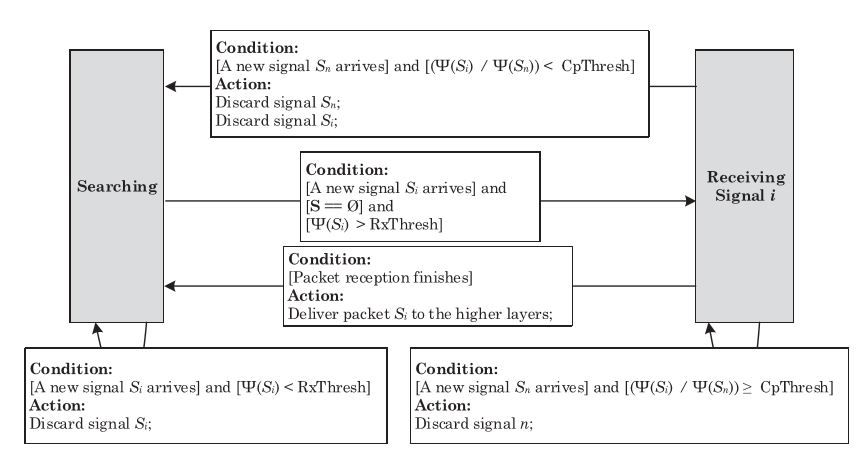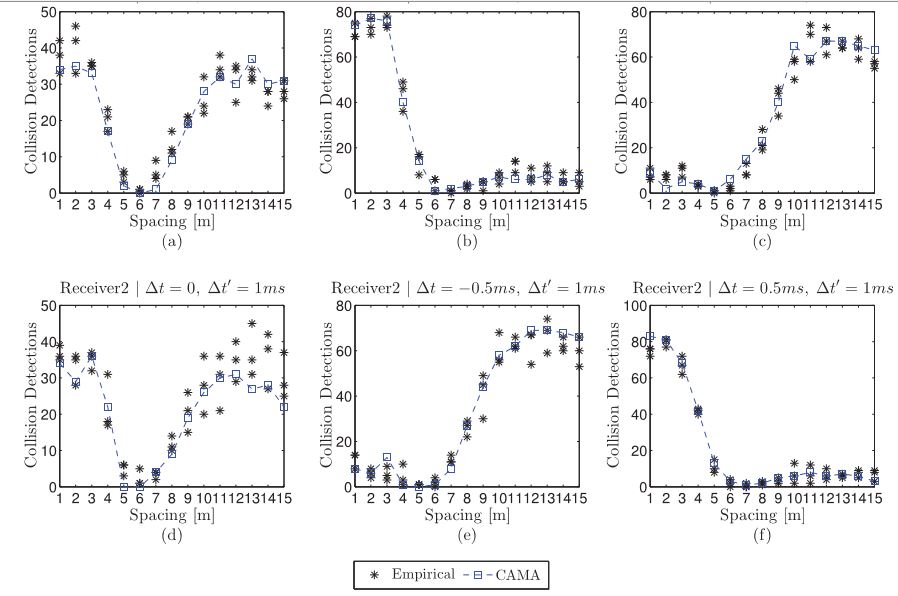ABSTRACT
Network simulation is an essential tool for the design and evaluation of wireless network protocols, and realistic channel modeling is essential for meaningful analysis. Recently, several network protocols have demonstrated substantial network performance improvements by exploiting the capture effect, but existing models of the capture effect are still not adequate for protocol simulation and analysis.
Physical-level models that calculate the signal-to-interference-plus-noise ratio (SINR) for every incoming bit are too slow to be used for large-scale or long-term networking experiments, and link-level models such as those currently used by the NS2 simulator do not accurately predict protocol performance. In this article, we propose a new technique called the capture modeling algorithm (CAMA) that provides the simulation fidelity of physical level models while achieving the simulation time of link-level models.
We confirm the validity of CAMA through comparison with the empirical traces of the experiments conducted by various numbers of CC1000 and CC2420-based nodes in different scenarios. Our results indicate that CAMA can accurately predict the packet reception, corruption, and collision detection rates of real radios, while existing models currently used by the NS2 simulator produce substantial prediction error.
RELATED WORK
Modeling the Capture Effect
In NS2 CTM, when a sample packet Si arrives, the received signal strength of the packet (denoted by (Si)) is first compared with the receiver sensitivity value (RxThresh) to check whether it is eligible for reception. If (Si) > RxThresh and no interference occurs during the packet reception, the packet is assumed to be successfully received.
If a new signal Sn arrives during a packet reception, NS2 CTM uses the capture threshold model: it compares the reception power of the packet currently being received with the reception power of the newly arrived packet. If (Si)/(Sn) ≥ CpThresh, packet reception is continued; otherwise, it discards both packets. The state machine of this model is demonstrated in Figure 1.

Fig 1. The State Machine of the Capture Model Employed by Ns2 Ctm
BACKGROUND
Radio Synchronization

Fig. 3. Sample packet formats using (a) CC1000 and (b) CC2420 radios. We refer to the last L settling bits of the preamble field as the settling bits
Specific frame synchronization bytes should be transmitted between the preamble bytes and data bytes. These bytes are usually called sync word, start bytes, or start of frame delimiter (SFD). The length and formatting of the preamble and start bytes may be different for various radios, and also depend on the MAC protocol implementation. If at least L settling bits are required for a proper synchronization, we refer to the last L settling bits of the preamble field as the settling bits. Figure 3 shows sample packet formats and the positions of the settling bits.
MODELING THE CAPTURE EFFECT
Modeling Signal Arrival and Reception

Fig. 5. Utilizing the messaging and self-messaging mechanisms
Fig 5. Utilizing the messaging and self-messaging mechanisms for modeling radio synchronization and packet reception. These mechanisms are integrated with the state machine of CAMA to reduce the number of states and the overhead of fine-grained packet reception.
GENERAL CONFIGURATION OF THE EXPERIMENTS

Fig. 9. The three-node experiment conducted with Mica2 nodes
We developed a sophisticated simulation tool using the OMNeT++ [OMNeT++ 2014] simulation framework. The default parameters used in the experiments of this article are listed in Table III. The preamble size used for the Mica2 experiments was selected to provide the minimum settling bits. In addition, the packet format used for the TelosB experiments is in compliance with the 802.15.4 standard. For the empirical measurements with TelosB nodes, we employed channel 26 to avoid interference from nearby 802.11 networks. We present the results with median, lower quartile, and higher quartile.
VALIDATION AND COMPARISON
The Four-node Experiment
Fig.15. Comparing the number of collision detections obtained from the empirical measurements and CAMA. These results validate the accuracy of CAMA to generate the collision detection behavior of the CC2420 radio.
It also shows the number of collision detections. We did not show the number of collisions with NS2 AIM, because it was very inaccurate. Our results show that CAMA can regenerate the empirical trace of collision detection with high accuracy. Therefore, through the three-node and four-node experiments, we showed that CAMA can represent the collision detection efficiency achievable by the CC1000 and CC2420 radios.

Fig. 12. The topology of the four-node experiment conducted with TelosB nodes
We consider two senders and two receivers in the topology given in Figure 12. We also use a synchronizer node to trigger the senders. We introduce t, which indicates the exact timing difference between the transmissions of the senders. The two senders transmit concurrently when t=0, Sender1 transmits earlier when t=−0.5ms, and Sender2 transmits earlier when t = 0.5ms. Since we disabled CCA to avoid random delays, we observed that the senders send almost concurrently when t=0. Therefore, we did not observe any considerable number of collision detections. Accordingly, we introduce the second timing parameter, denoted by δt, which indicates the random delay chosen by the senders before transmission.
INVESTIGATING THE CAPTURE EFFECT IN WIRELESS SENSOR NETWORKS
In this section, we study the capture effect in large wireless sensor networks. Our investigations show that regardless of the carrier-sensing threshold and transmission power, a significant number of packet receptions is affected by high-power interference. We also perform sensitivity analysis of the capture effect to reveal the effects of design approaches and network parameters on the efficiency of collision detection and reception recovery.
CONCLUSIONS
In this paper, we introduced CAMA, an algorithm for improving the accuracy and efficiency of modeling the capture effect in low-power wireless networks. In addition to accuracy and scalability, CAMA also provides partial packet reception and enables the higher layers to obtain information about the collision status at the physical layer. These features provide opportunities for protocol improvements that have not been possible with packet-level simulators such as NS2.
Although CAMA has been presented and evaluated with respect to the characteristics of low-power radio transceivers, it is a general algorithm and can be integrated with various link models. Moreover, CAMA is a physical-layer algorithm and it is independent of MAC-layer implementation. In addition to these features, since CAMA supports preamble and packet body capture, it can also be used for simulating 802.11 networks where the reception probabilities of preamble and packet body are different. We leave this study as a future work.
We performed experiments with various radios and under different topologies to validate the operation of CAMA. While CAMA could regenerate the empirical traces, we precisely highlighted the inherent inaccuracies of the capture models employed by NS2. Furthermore, through evaluating CAMA and NS2 in various scenarios, we showed that the capture models of NS2 cannot provide accurate collision detection information. These results also showed that, using small-size preambles, the simulation speed of CAMA is less than 30% lower than that of NS2 capture models. However, as the preamble size enlarges (i.e., duty cycle reduces), the speed improvement of CAMA is higher than that of NS2.
Source: University Teknologi Malaysia
Authors: Behnam Dezfouli | Marjan Radi | Kamin Whitehouse | Shukor Abd Razak | Hwee-pink Tan
>> Wireless Sensor Networks Projects Abstract for Final Year Students
